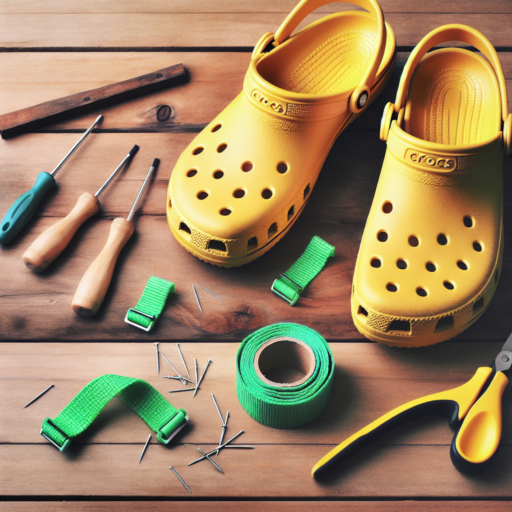Why do Crocs have holes in the front?
The distinctive design of Crocs, featuring numerous holes at the front, isn’t just a unique aesthetic choice; it serves several practical purposes. One primary reason is ventilation. These holes allow for increased airflow, keeping the wearer’s feet cool and reducing sweat accumulation. This is particularly beneficial in warm weather conditions, making Crocs a favorite among those seeking comfortable, breathable footwear.
Another key aspect is water drainage. Crocs are often used in wet environments, such as at the beach, around pools, or in gardens. The holes in the front allow water to escape easily, preventing water from being trapped inside the shoe, which could lead to discomfort or even the development of mildew. This drainage system ensures that the shoes dry quickly and remain comfortable and clean with minimal maintenance.
Customization is another reason behind the inclusion of holes in Crocs. Wearers can personalize their Crocs using Jibbitz, which are decorative charms that can be clipped onto the holes. This feature has made Crocs not just a shoe but a form of self-expression, allowing users to personalize their footwear according to their style, interests, or mood. The holes thus serve a dual purpose of functionality and fashion, contributing to the global popularity of Crocs.
Why are there Crocs in Theatre?
The presence of Crocs in theatre settings might initially seem peculiar to many. However, this trend isn’t without good reason. Crocs, famous for their comfort and practicality, have found a surprising foothold in the performing arts sector.
Firstly, the unparalleled comfort offered by Crocs is a significant factor. Theatre professionals, including actors, technicians, and directors, often work long hours, spending a substantial amount of time on their feet. The lightweight design and supportive structure of Crocs help mitigate foot fatigue, making them an ideal choice for backstage and on-stage work.
Another reason is the versatility and convenience of Crocs. Available in a variety of colors and styles, they easily slip on and off, which is perfect for quick costume changes or moving between different areas of the theatre. Furthermore, Crocs are made from Croslite, a material that is both easy to clean and resistant to odors, addressing hygiene concerns in busy theatre environments.
In addition, Crocs have, quite surprisingly, been embraced for their aesthetic flexibility. With the advent of custom charms and a wide range of colors, Crocs can be styled to fit the theme of a production or the personal style of the wearer, adding a layer of personal expression in the theatre setting.
Is there a difference between Crocs and fake Crocs?
The question of whether there is a difference between Crocs and fake Crocs might seem straightforward, but it unpacks a variety of considerations from quality to comfort, and durability. At first glance, counterfeit Crocs might resemble their genuine counterparts in terms of design and color. However, the nuances distinguishing authentic Crocs from their imitations are evident upon closer inspection.
One of the primary differences lies in the material quality. Genuine Crocs are made with a proprietary resin called Croslite, which provides a unique blend of softness, durability, and odor resistance. This material also accounts for the lightweight feel and cushioning effect, distinguishing Crocs’ comfort level from that of many other footwear. On the other hand, knock-offs often use inferior materials that compromise not only the feel but also the functionality of the shoes. These substitutes may lead to discomfort and even health issues like blisters or poor posture.
Furthermore, the longevity and durability of genuine Crocs considerably surpass those of fake ones. Original Crocs showcase a remarkable resistance to wear and tear, maintaining their shape and comfort over prolonged periods of use. Counterfeits, in contrast, may deteriorate quickly, losing their shape and vibrant color, making them a less economical choice in the long run. The security features, such as slip-resistant and non-marking soles, are often overlooked in the production of fake Crocs, thus compromising user safety.
Why are Crocs so expensive?
Many shoppers find themselves pondering over the price tag attached to Crocs, a brand known for its unique foam clog footwear. While they’re prized for comfort and versatility, the question of their seemingly high cost is common. The justification behind the expense is multifaceted, involving innovative design, extensive branding efforts, and the brand’s positioning in the market.
The Cost of Comfort and Design
At the heart of Crocs’ pricing strategy is their proprietary Croslite material, a revolutionary closed-cell resin that offers the soft, comfortable, lightweight, and odor-resistant qualities Crocs are famous for. This material is not cheap, and the research and development involved in perfecting such a product contribute significantly to the cost. Furthermore, the brand’s commitment to producing a wide range of designs, colors, and collaborations adds to the production costs, making them more expensive than your average footwear.
Branding and Market Position
Crocs is not just selling footwear; they are selling a brand experience. Their marketing efforts and collaborations with high-profile celebrities and designers create a perceived value that goes beyond the physical product. These collaborations often result in limited edition models, which are inherently pricier due to their exclusive nature. Moreover, Crocs have successfully positioned themselves as both a fashion statement and a pragmatic choice, appealing to a broad audience that includes everyone from healthcare workers to fashion enthusiasts.
Understanding the factors that contribute to the cost of Crocs—from the unique materials and design process to the strategic market positioning and branding efforts—sheds light on why these popular shoes come with a higher price tag. While they may be more expensive than other casual footwear, many find the comfort, durability, and style of Crocs to be worth the investment.









